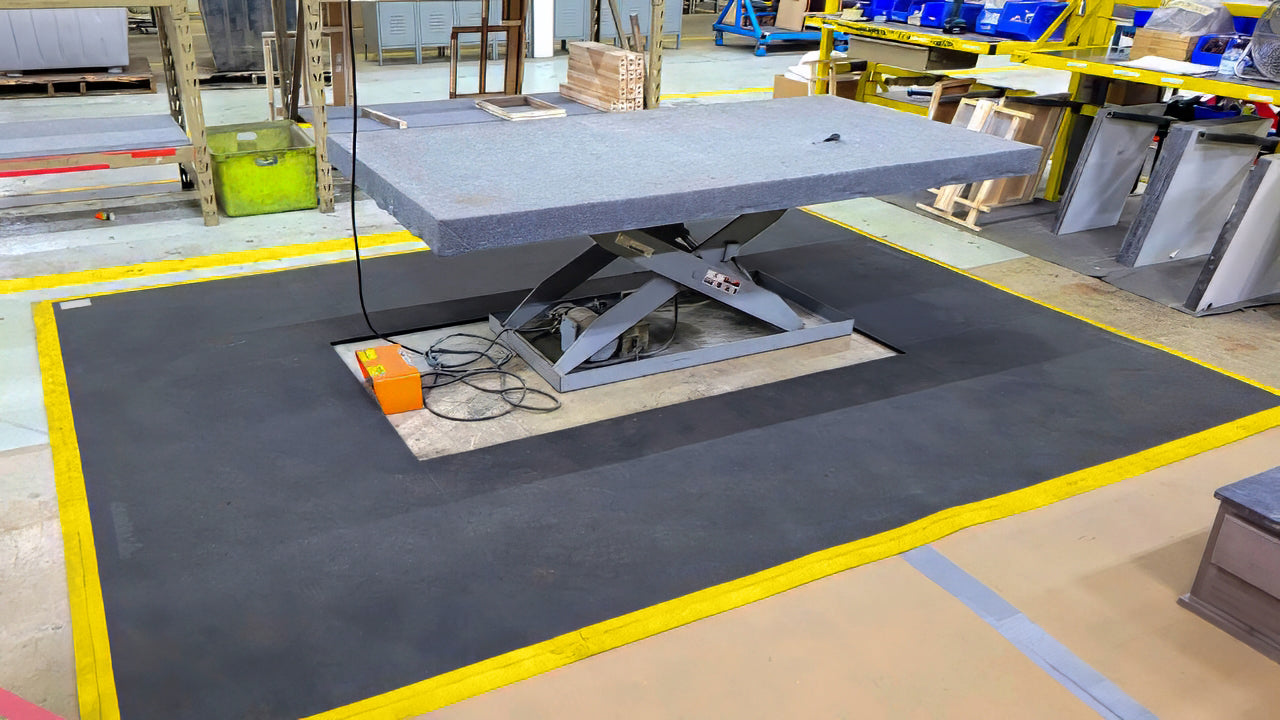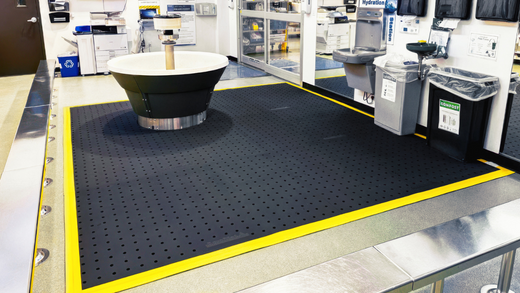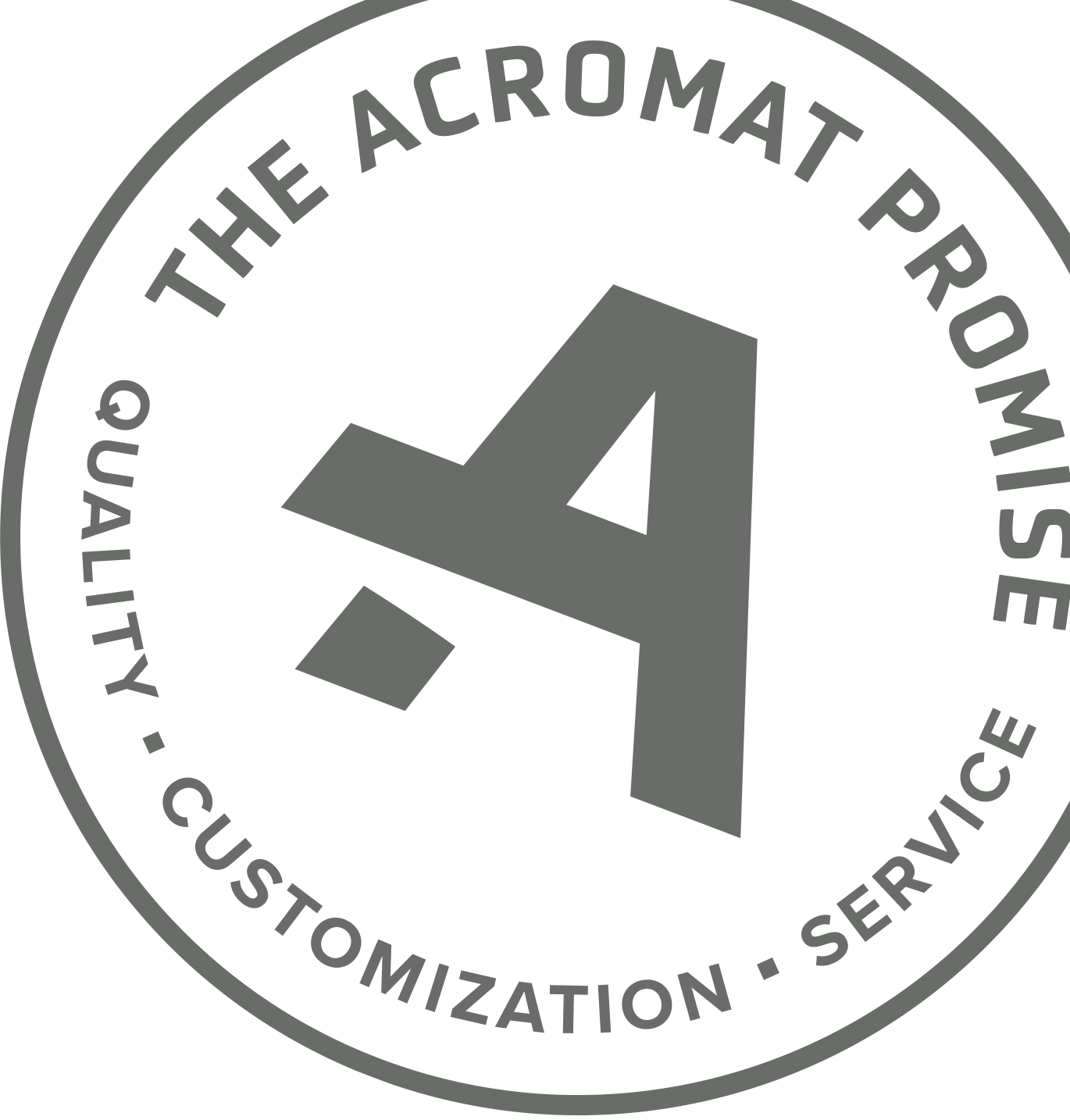Musculoskeletal disorders (MSDs), or ergonomic injuries, are the leading cause of workplace absenteeism. Research also shows that the development of MSDs are directly connected to work environment.
In brief, your workplace is either proactively preventing MSD injuries or it's contributing to more of them. The right anti-fatigue mats can play a key role in prevention efforts.
Below, a closer look at how right anti-fatigue mats prevent MSDs.
What is the Relationship Between Absenteeism and MSDs?
The absenteeism rate in the U.S. is 3.1% across all industries, meaning at any given time 3% of your workforce is missing work due to an illness or injury. This costs U.S. companies over $225 billion in lost production on a yearly basis.
According to the Occupational Safety and Health Administration, “MSDs are among the most frequently reported causes of lost or restricted work time” (absenteeism).
According to the National Institute for Occupational Safety and Health, there is a direct connection between work environment and the development of MSDs.
According to the Centre of Research Expertise for the Prevention of MSDs (CRE-MSD), anti-fatigue mats can reduce pain and discomfort caused by long-term standing by up to 50% compared to hard surfaces like tiles, hardwood, concrete, and metal grating.
MSDs develop gradually over time and are injuries that impact muscles, tendons, nerves, cartilage, joints, and the spine. Common MSDs include:
- Arthritis
- Rotator cuff strains
- Tendonitis
- Sciatic nerve issues
- Plantar fasciitis
- Shin splints
- Neck/back pain
- Inflammation/swelling
6 ways anti-fatigue mats help prevent MSD injury:
1. Anti-fatigue mats reduce pain and discomfort by 50%
Dr. Andrew Laing with the University of Waterloo joined a recent CRE-MSD webinar – Anti-Fatigue Mats and Their Relationship to MSD Prevention – to share how anti-fatigue mats support the prevention of MSD injuries.
As part of his years-long research into the effectiveness of anti-fatigue mats, Dr. Andrew's team had 16 individuals over two days stand on hard surfaces (RIGID) for 60 minutes, followed by standing on a nitrile anti-fatigue mat (AFM) for 60 minutes. They looked closely at three key areas: body posture, body movement, and pain or discomfort.
 Screenshot from webinar showing how Dr. Andrew measured posture, body movement and discomfort. Of note, pure 100% nitrile is what we use to make our mats here at AcroMat.
Screenshot from webinar showing how Dr. Andrew measured posture, body movement and discomfort. Of note, pure 100% nitrile is what we use to make our mats here at AcroMat.
Eight of the individuals were considered “pain developers” (PDs) – meaning they become physically uncomfortable in less than 60 minutes standing. The other eight were “non-pain developers (NPDs)” – meaning they can comfortably stand for 60 minutes.
The eight pain developers experienced a 50% reduction in lower back pain and physical discomfort standing on the nitrile mat (AFM) compared to the hard surface (RIGID).

Screenshot from webinar showing the 50% decrease in lower back pain for pain developers. "Those pre-disposed to pain experienced significant relief when standing on the AFM compared to RIGID floor,” shared Dr. Andrew.
According to Dr. Andrew's research, roughly 30-50% of the world's population are pain developers and would benefit from using anti-fatigue mats over hard surfaces.
2. Anti-fatigue mats prevent static positions
Specific to standing workers, MSD injuries often develop when we're in a static position for an extended period. When static, the same muscle tissues are loaded, there is a pooling of fluid in our lower limbs along with a build-up of metabolic waste, and each of these collectively contribute to the development of pain in our muscles and joints.
In short, prolonged pain leads to the development of recordable MSD injuries.
Unlike hard surfaces, anti-fatigue mats intentionally create subtle instabilities. These slight movements help our bodies share tissue loading between muscles, force our muscles to remain engaged to keep us balanced, and create consistent muscle pumps.
In summary, 4 ways anti-fatigue mats work to prevent static standing:
- Anti-fatigue mats decrease static positioning by consistently, though subtly, activating the muscles – reducing risks of locked limbs and stiffness.
- Anti-fatigue mats prevent the same muscle tissues from being loaded, reducing the risk of overexertion in any one area. Stated more simply, they help your body "share the load."
- Anti-fatigue mats prevent pooling of fluids in our lower limbs and encourage healthy blood flow to/from the heart, reducing the risk of painful varicose veins and similar issues.
- Anti-fatigue mats decrease the buildup of metabolic waste, reducing risks of pain, discomfort and ultimately recordable MSD injuries.
 Anti-fatigue mats soften joint impact, keep your muscles warm and engaged, and encourage healthy blood flow – all of which reduce the risk of MSD injuries. AcroMat 100-1 Series mat for Nokian Tyres.
Anti-fatigue mats soften joint impact, keep your muscles warm and engaged, and encourage healthy blood flow – all of which reduce the risk of MSD injuries. AcroMat 100-1 Series mat for Nokian Tyres.
3. Anti-fatigue mats don't make you less tired
Anti-fatigue mats don’t actually make you less fatigued; we all get tired when working on our feet for hours at a time regardless of what's beneath our feet. However, as described in more detail above, they do reduce pain and discomfort which in turn helps prevent injury.
Proven ergonomic support keeps you healthier, stronger, and more physically and mentally available at work and home. This is where "anti-fatigue" is derived from.
One important key is finding a material that will not sink or flatten underfoot. PVC foam, the most common material used to make anti-fatigue mats, goes flat over time and heavy use. Conversely, 100% nitrile rubber foam, never sinks or flattens.

Made from 100% nitrile rubber foam, the AcroMat 100-1 Series, 100-ESD Series, and 100-Cleanroom Series mats are guaranteed to never sink, flatten, or lose their ergonomic cushion from being stood on. The medium-soft cushion stays 100% intact indefinitely.
4. Anti-fatigue mats that are too soft can reduce balance
Have you noticed when standing how our bodies naturally sway? This is our center of mass (COM) moving back and forth. The center of pressure (COP), under our feet, are the forces that come from the ground into our body. We use the COP to try and control COM, which keep us upright and balanced.
In brief, our bodies are always working to keep us balanced. The right anti-fatigue mat materials complement and encourage this natural sway by keeping your body active and engaged.
However, if you introduce an anti-fatigue mat that is too soft, too thick, or if you're stacking your mats, they can work against your ability to remain balanced – increasing the rate of fatigue in addition to slip, trip, and fall risks.
AcroMat anti-fatigue mats have been strategically designed and tested over 20 years to provide a precise balance between stability and support. The medium-soft cushion provides unending comfort, while the firmness keeps your ankles from sinking and causing pain.
Ergonomist Crystal Nelson and AcroMat General Manager Russell Herbert discuss the ideal anti-fatigue mat thickness and whether your mats can be too soft. According to Crystal, between 5/8" and 3/4" is the ideal thickness for posture and traction.
5. Anti-fatigue mats reduce impact injuries by 70%
Anti-fatigue mats offer more than just ergonomic support; they reduce impact injury risks compared to falling on hard surfaces like cement, wood and metal. According to CRE-MSD research highlighted in the webinar:
- Falling on a nitrile anti-fatigue mat reduces hip impact by up to 50%.
- Falling on a nitrile anti-fatigue mat reduces head impact by up to 70%.
This is one reason why, here at AcroMat, a custom anti-fatigue mat manufacturer, "custom" means any shape and size and why we often cover entire workstations with one-piece designs; custom mats cushion every step while also softening fall impact.
 This 2,000+ sq. ft. custom nitrile anti-fatigue mat is providing this windows manufacturer with seamless ergonomic support, traction, and has created a soft landing if someone falls or drops vulnerable equipment.
This 2,000+ sq. ft. custom nitrile anti-fatigue mat is providing this windows manufacturer with seamless ergonomic support, traction, and has created a soft landing if someone falls or drops vulnerable equipment.

Medtronic covered this often-wet workspace traction and cushion; if someone were to fall on the mat, the risk of impact injury would be 70% less than a hard surface.
6. Anti-fatigue mats are more effective than insoles
Dr. Andrew's team found "moderate" evidence that anti-fatigue mats help reduce pain, especially for the 30-50% of standing workers worldwide who are prone to discomfort when standing ("pain developers").
Comparatively, his team found “very limited” evidence insoles do the same. In fact, Dr. Andrew noted how “impacting the geometry of the shoe” – e.g., raising the foot too far from the shoe base with an insole – may increase the risk of slips, trips and falls because you’re less in control of your balance.
How are Safety Leaders Reducing MSD Injury Risks?
Anti-fatigue mats are one proven solution, but there are a number of options today's safety leaders are investing in to support their people. Based on conversations with ergonomists and occupations therapists, here are a few proactive approaches:
- Rotating shifts
- Orthopedic insoles
- Anti-fatigue / ergo mats
- Work table height assessments
- Ergonomic inspections and workshops
- Chiropractic care built into health plans
- Mandatory pre- and post-shift stretching routines
Preventing MSDs doesn't have to be complicated. Get a free sample of an AcroMat anti-fatigue mat to test the support yourself.




